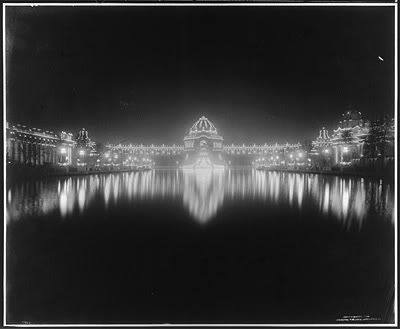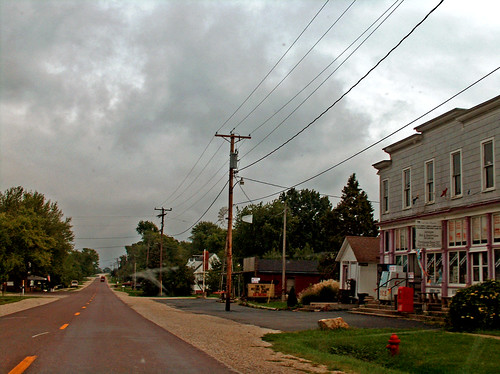Blue Highways: Tell City, Indiana
Click on Thumbnail for MapUnfolding the Map
I just saw a comic strip the other day with William Tell as its subject. He seems to come up a lot in the comics as I've seen a few strips with him as the subject. The reason I mention this? William Least-Heat Moon drives through his namesake Tell City along blue highways. Follow us by clicking on the map.
Book Quote
"At the Huntingburg exit, I turned off and headed for the Ohio River. Indiana 66, a road so crooked it could run for the legislature, took me into the hilly fields of CHEW MAIL POUCH barns, past Christ-of-the-Ohio Catholic Church, through the Swiss town of Tell City with its statue of William and his crossbow and nervous son."
Blue Highways: Part 1, Chapter 5
 Barn advertising Mail Pouch tobacco in Ohio
Barn advertising Mail Pouch tobacco in Ohio
Tell City, Indiana
I never chewed. While friends around me would pull out their cans of chew, grab a pinch, and stuff it their cheeks until it looked like they had some kind of growth on their face, I would simply watch. We'd talk, and they'd take a second to hold up a can or a bottle near their lips, spit the juice into the the can, and then put the can down to continue talking. This was especially dangerous at parties, where if a person put his or her can of beer down, momentarily forgot where it was, and reached for the can at hand, an unpleasant surprise might await with a healthy swig. Speaking of that, here's a good song by Robert Earl Keen titled Copenhagen. It extolls the pleasures and pain of chewing that particular brand.
Of course, most of my friends weren't chewing Mail Pouch tobacco. I think I would have actually thought that was pretty cool if they did. That would have been way too retro for my friends. Instead they were chewing the cheap and popular stuff. The lightweights were chewing Skoal, which I remember had a minty smell to it. The harder core kids chewed Copenhagen. You were a real wimp if you used the packets that looked like little teabags with the pre-measured amounts of tobacco. The only guys I saw chewing tobacco from a pouch were older men, and the tobacco looked a lot different, more stringy and leafy.
One of the great pleasures of traveling back roads of America, which Least-Heat Moon (LHM) captures in this quote, is driving through small towns and through pastoral settings where you can still find gliimpses of old highway advertisements painted on the sides of buildings, like the Mail Pouch ads on the sides of barns. It brings to life old time advertising, before television and radio were big, and in a more picturesque way than the lines of billboards that we have lining the interstates today. The old ads conveyed a simpler time, when people and life traveled much more slowly. There was even room for creativity, as the old Burma-Shave signs on the side of the road that spelled out complete ads a few words at a time as you traveled down the road.
And then, the towns, where ads were strategically painted on the sides of buildings, and often outlived the companies whose products they advertised. Occasionally, on a walk through my hometown, or in the city where I now live, I'll come upon one of those ads and be momentarily transported back to the time when the ad truly meant something to the people who saw it.
The other thing that LHM, in his eye for detail, focuses briefly on is the statue. Every town has a statue or a monument to something, and these are often interesting to look at especially if they are a little out of the ordinary. In Tell City's case, as it was named for William Tell, it has a statue depicting the legend of William Tell shooting the apple off of his son's head with an arrow. In my hometown it was a section cut out of a huge redwood log with markers at rings representing significant years in human history.
My wife and I were once traveling in Florida, and stopped off in Kissimmee to see the Monument of States. Basically, this was a pylon of rocks cemented together. Each rock was contributed by a state in the United States, and therefore it represented the geologic variety of the whole country. It sat forlornly, off on a side street near the water, and I had the distinct feeling that not many people went there.
Just before the passage I quote above, LHM writes: "Life doesn't happen along interstates. It's against the law." If you are going to see some of these relics of earlier times, you have to cut down your speed and drive the smaller roads.
If you want to know more about Tell City
City of Tell City
Flood Wall Mural
Perry County (Tell City) News (newspaper)
Tell City Historical Museum
Tell City Pretzel Company
Wikipedia: Tell City
William Tell and son statue
Next up: Cannelton, Indiana




 Friday, May 28, 2010 at 9:56AM
Friday, May 28, 2010 at 9:56AM


